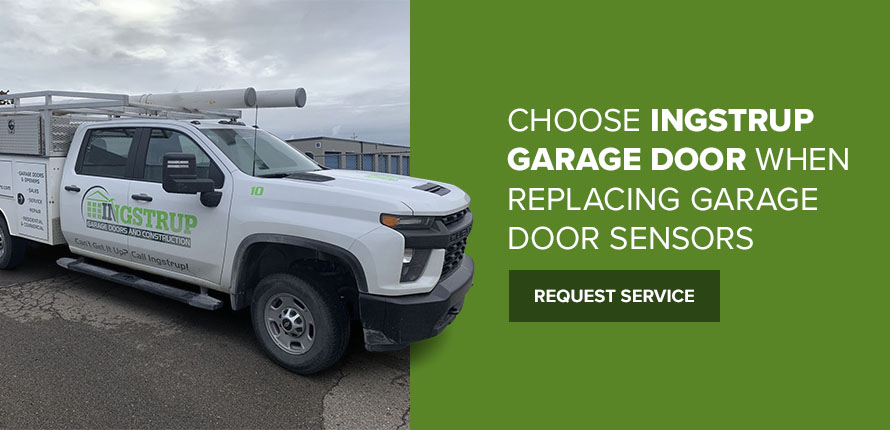Since 1993, automatic garage doors installed in U.S. homes have been required to have at least one type of safety mechanism to prevent entrapment under the door. These safety mechanisms include garage door sensors, which detect objects, people or animals who may be in the garage door’s path.
Your garage door’s safety sensor plays a critical role in protecting people and pets from harm. However, this feature can wear out or need replacement eventually. Fortunately, you can look for a few signs to know when it’s time to replace your garage door sensor.
What Does a Garage Door Sensor Do?
A garage door sensor detects when something is underneath a garage door and is at risk of being crushed when it closes. Several types of sensors are available, with a common type being a photo-eye sensor. This equipment, also known as a safety eye, consists of two components that look like small cameras. The components are placed on opposite sides of the garage door frame, between 2 and 6 inches above the floor.
When the sensor is activated, the photo-eye components send a photoelectric beam across the door opening. If anything is in the door opening, such as a garbage can, a dog or a small child, it blocks the beam, and the garage door sensor prevents the door from closing. If the door is in the process of closing when the sensor detects an object, the door will reverse direction and open.
Sometimes, the safety eyes become misaligned, which interferes with their functionality. When the eyes don’t line up, they can’t create a beam, so the sensor thinks that something is blocking the door.
How to Detect Garage Door Sensor Misalignment
Misalignment is common because safety eyes sit low to the ground, making them easy for someone walking by or a child or pet playing near the garage door to bump. The door’s vibrations as it opens and closes can also knock the photo-eye sensors out of alignment.
Performing a Visual Inspection
A visual inspection can help you determine if the safety eyes are misaligned. First, close the garage door manually.
Walk over to one of the photo eyes and look at the light on it. The sensor is aligned and in working order if it has a solid yellow or green light. Next, check the other sensor to see if its light is solid yellow or green.
If you see a flashing light on either of the photo eyes, that signals a misalignment.
Fixing Misalignment
You can often correct a misalignment on your own by adjusting the sensors. Measure the height of each sensor from the ground and confirm that the heights are the same. If they aren’t, raise or lower the sensors until they are equidistant from the ground. Use a level to confirm that they are even.
A sensor may be misaligned because it’s become loose. If you can wiggle the sensor back and forth, it needs to be tightened. There may be a nut or screw you can manually tighten after realigning the photo eye.
After adjusting the safety eyes to fix the misalignment, test to see if that fixed the issue. The light on each photo sensor should be solid. Open the garage door, then close it using the remote control. If the door closes fully, you’ve fixed the alignment problem.
Signs of a Broken Garage Door Sensor
While misaligned photo eyes are a common cause of garage door sensor problems, there may be something else going on with your sensors. If the safety eyes aren’t misaligned or correcting the misalignment doesn’t fix the issue, inspect the photo-eye sensors again.
It could be the case that the sensors are dirty and the dirt is blocking the beam. Try wiping them clean with a soft microfiber cloth.
Sun Damage
The sun’s ultraviolet rays can prevent a garage door sensor from working and cause damage to the sensors. Photo-eye sensors use infrared light to create a beam that detects objects. The sun also produces infrared light, which can disrupt the beam if it shines on a sensor.
Depending on where the sunlight hits your garage, a quick fix may be to switch the positions of your sensors so that the transmitting sensor is on the side of the door that doesn’t experience direct sunlight. Another option is to install a sun shield in front of the sensor to block the sun’s rays but not the sensor’s beam.
If prolonged sun exposure has damaged the sensors, your best option is most likely to replace them.
Power Issues
Another issue could be that the sensors aren’t getting any power. If you don’t see a light on either sensor, check the power supply. Try unplugging and replugging it or inspect your circuit breaker to confirm that the circuit hasn’t tripped.
Sometimes, a frayed or loose wire may disrupt the power to the sensor, too. When a wiring issue is causing problems with your garage door sensor, it’s usually time to replace the sensor.
If you suspect that a wiring issue is to blame for your sensor problems, your best option is to call in a professional for service and repair.
How Much Does Garage Door Sensor Replacement Cost?
The cost to replace a garage door sensor depends on the type of sensor you use and whether you replace it yourself or call a professional garage door technician for installation and repair. Once you’ve replaced your sensors, ongoing maintenance will help to prolong their life and reduce the need for future replacement. Keep the sensors clean and away from direct sunlight, too.
Choose Ingstrup Garage Door When Replacing Garage Door Sensors
Ingstrup Garage Doors has served Lansing, Michigan, and the surrounding area for more than 25 years. We’re your go-to company for garage door maintenance, parts and repairs. If your garage door sensor isn’t working as it should, give us a call at (517) 374-4731 or request service online.


